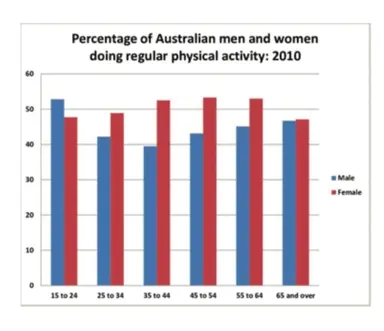
Question:
The bar chart illustrates the percentage of Australian men and women in different age groups who did regular physical activity in 2010. Summarise the information by selecting and reporting the main features, and make comparisons where relevant.

Band 9 Answer
The bar chart illustrates the percentage of Australian men and women, segmented by age groups, who engaged in regular physical activity in 2010. Overall, the chart reveals that while the youngest age group (15-24 years) shows a slightly higher participation among men, from the age of 25 onwards women consistently exhibit higher levels of physical activity. Moreover, the data indicates a general decline in activity rates as age increases, with a notable convergence in the oldest age group.
In detail, for the 15-24 age group, approximately 52% of men participated in regular physical activity compared to around 48% of women. In the 25-34 bracket, the trend reverses with men at roughly 48% and women at about 53%. The disparity becomes even more pronounced in the 35-44 group, where only about 39% of men were active, whereas the figure for women rose to nearly 52%. This significant gap continues in the 45-54 and 55-64 age categories, although it narrows somewhat; for instance, in the 55-64 group, men recorded around 42% participation versus 48% for women. By the time individuals reach the 65+ category, the percentages almost equalise, with approximately 46% of men and 47% of women engaging in regular exercise.
These figures suggest that while young men may initially be more active, a shift occurs as people age, with women maintaining a higher level of physical activity during middle age, before the rates converge in later years.
Vocabulary
- Illustrates
- Segmented
- Exhibit
- Consistently
- Pronounced
- Disparity
- Convergence
- Reverses
- Narrow
- Maintain
Band 8 Answer
The bar chart compares the percentage of Australian men and women in various age groups who took part in regular physical activity in 2010. Overall, the chart shows that men in the 15-24 age group had a slightly higher rate of participation than women, but from the 25-34 age group onward, women tended to be more active. Additionally, there is a general decline in physical activity as age increases, with the gender gap narrowing among the elderly.
Specifically, in the 15-24 age group, about 52% of men exercised regularly, compared to 48% of women. In the next age group (25-34), the figures were around 48% for men and 53% for women. The largest difference is seen in the 35-44 group, where approximately 39% of men and 52% of women were active. In older age groups such as 55-64, men and women recorded around 42% and 48% respectively, and by 65+, both genders were almost equal at roughly 46% for men and 47% for women.
Overall, the chart indicates that while younger men are more active, women become more physically active from early adulthood until later life, where the difference becomes minimal.
Vocabulary
- Compares
- Participation
- Took part
- Decline
- Narrowing
- Specifically
- Recorded
- Almost equal
- Indicates
- Minimal
Band-7 Answer
The bar chart shows the percentage of Australian men and women in different age groups who did regular physical activity in 2010.
It can be seen that in the 15-24 age group, men had a higher participation rate (about 52%) than women (around 48%). However, from the age of 25 onwards, women participated in regular exercise at higher rates than men. For example, in the 25-34 age group, about 48% of men and 53% of women were active.
The difference between genders becomes most noticeable in the 35-44 group, where only about 39% of men took part in physical activity, compared to roughly 52% of women. Although both genders show a decline in activity as they age, by the 65+ group, the percentages come very close, with approximately 46% of men and 47% of women exercising regularly.
Overall, the chart suggests that while young men are slightly more active, women are generally more engaged in physical activity from early adulthood until old age.
Vocabulary
- Participation rate
- Engaged
- Noticeable
- Decline
- Takes part
- Approximately
- Slightly
- Generally
- From early adulthood
- Old age
Band-6 Answer
The bar chart shows the percentage of Australian men and women in different age groups who did regular physical activity in 2010.
In the 15-24 age group, about 52% of men did exercise regularly, while around 48% of women did so. In the 25-34 group, the numbers change, with about 48% of men and 53% of women taking part in regular physical activity.
The biggest difference is seen in the 35-44 age group, where roughly 39% of men exercised regularly compared to about 52% of women. In the older groups, the activity levels for both genders drop, and by the 65+ group, around 46% of men and 47% of women are active.
Overall, the chart shows that young men are a bit more active, but as people get older, women tend to exercise more than men, until the gap almost disappears in the oldest age group.
Vocabulary
- Regular physical activity
- Percentage
- Did exercise
- Took part
- Biggest difference
- Drop
- Active
- Gap
- Almost disappears
- Oldest age group
Connectors Used
- Overall
- However
- While
- From
- For example
- In contrast
- Then
- Although
- By the time
- Thus












 Here can be your custom HTML or Shortcode
Here can be your custom HTML or Shortcode
0 Comments